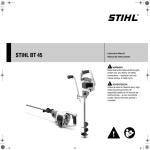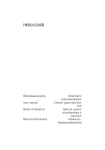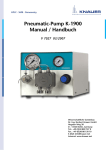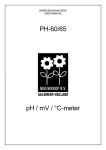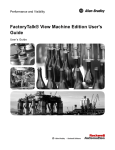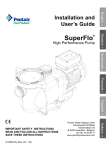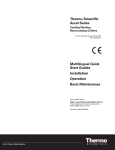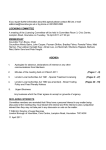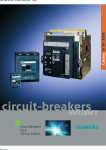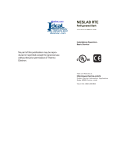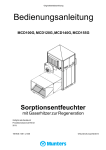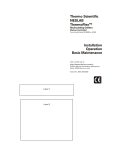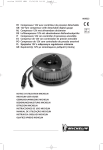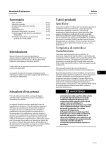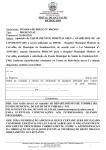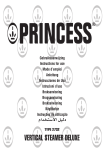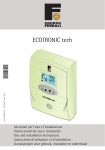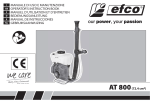Download ThermoChill LR Recirculating Chillers User Manual
Transcript
Thermo Scientific ThermoChill LR Recirculating Chillers Thermo Scientific Manual P/N U01198 Rev. 01/31/2013 Installation Operation Basic Maintenance Visit our Web site at: http://www.thermoscientific.com/tc Product Service Information, Applications Notes, MSDS Forms, e-mail. Voice Info: (800) 258-0830 Thermo Scientific ThermoChill LR Recirculating Chillers Thermo Scientific Manual P/N U01198 Rev. 01/31/2013 Installation Operation Basic Maintenance Visit our Web site at: http://www.thermoscientific.com/tc Product Service Information, Applications Notes, MSDS Forms, e-mail. Voice Info: (800) 258-0830 Label Thermo Fisher Scientific Sales, Service, and Customer Support 25 Nimble Hill Road Newington, NH 03801 Tel : (800) 258-0830 or (603) 436-9444 Fax : (603) 436-8411 www.thermoscientific.com/tc 25 Nimble Hill Road Newington, NH 03801 Tel: (800) 258-0830 Sales: 8:00 am to 5:00 pm Service and Support: 8:00 am to 6:00 pm Monday through Friday (Eastern Time) Fax: (603) 436-8411 [email protected] Dieselstrasse 4 D-76227 Karlsruhe, Germany Tel : +49 (0) 721 4094 444 Fax : +49 (0) 721 4094 300 [email protected] Building 6, No. 27 Xin Jinqiao Rd., Shanghai 201206 Tel : +86(21) 68654588 Fax : +86(21) 64457830 [email protected] Ion Path, Road Three, Winsford, Cheshire, CW73GA, United Kingdom Phone: +44 (0)8706 099254 Fax: +44 (0)1606 548103 Statement of Copyright Copyright © 2013 Thermo Fisher Scientific. All rights reserved. This manual is copyrighted by Thermo Fisher Scientific. Users are forbidden to reproduce, republish, redistribute, or resell any materials from this manual in either machine-readable form or any other form. Contents Quick Start Guides Preface ..................................................................................................................................i Compliance...............................................................................................................i WEEE ......................................................................................................................i After-Sale Support..................................................................................................ii Unpacking................................................................................................................ii Warranty...................................................................................................................ii Feedback...................................................................................................................ii Section 1 Safety...................................................................................1-1 Warnings...............................................................................................................1-1 Section 2 General Information..............................................................2-1 Description..........................................................................................................2-1 Specifications.......................................................................................................2-1 Wetted Materials..................................................................................................2-4 Section 3 Installation............................................................................3-1 Site Requirements...............................................................................................3-1 Electrical Requirements.....................................................................................3-2 Plumbing Requirements.....................................................................................3-3 Process Fluid Requirements..............................................................................3-4 Compatibility with Approved Fluids...............................................................3-5 Process Water Quality and Standards..............................................................3-6 Filling ...................................................................................................................3-7 External Pressure Regulator (Optional)..........................................................3-8 Hose Kit (Optional)...........................................................................................3-9 Section 4 Operation.......................................................................................................... 4-1 Controller.............................................................................................................4-1 Start Up/Shut Down..........................................................................................4-2 Circuit Protector.................................................................................................4-2 Start Up................................................................................................................4-2 Setpoint................................................................................................................4-2 Temperature Alarm............................................................................................4-3 Serial Comm (Optional).....................................................................................4-3 Setup/Tune Loop...............................................................................................4-4 Stopping...............................................................................................................4-6 Draining................................................................................................................4-6 Shipment/Storage...............................................................................................4-6 Decommissioning/Disposal.............................................................................4-7 Thermo Scientific ThermoChill Contents Section 5 Section 6 Preventive Maintenance............................................................................... 5-1 Cleaning................................................................................................................5-1 Condenser............................................................................................................5-1 Fluid Maintenance..............................................................................................5-1 Reservoir..............................................................................................................5-1 Pump Strainer......................................................................................................5-2 Hoses ...................................................................................................................5-2 Temperature Sensor (rdt1) Calibration............................................................5-3 Troubleshooting......................................................................6-1 Error Codes.........................................................................................................6-1 Checklist...............................................................................................................6-2 Displaying Software Version.............................................................................6-4 Controller PID Values.......................................................................................6-4 Flow Diagram Appendix Declaration of Conformity WARRANTY ThermoChill Serial Communications Thermo Scientific Quick Start Guide Safety Precautions: The chiller is designed for indoor use only. Never place the chiller in a location where excessive heat, moisture, inadequate ventilation, or corrosive materials are present. Never use corrosive fluids with this chiller. Never connect process fluid lines to your facility water supply or to any pressurized liquid source. If your chiller is equipped with a positive displacement pump (PD1 or PD2), ensure your application plumbing lines and fittings are rated to withstand a minimum of 115 psi. Before using any fluid or performing maintenance where contact with the fluid is likely refer to the manufacturer’s MSDS for handling precautions. Circuit Protector J1 Serial Communications (Optional) 4 Power Inlet 1 3 Process Inlet 1/2" FNPT Brass 1 Connect the process OUTLET to the fluid inlet on your application. Connect the process INLET to the fluid outlet on your application. Ensure all connections are secure and that the proper sealant/lubricant for the fitting material is used. (If Teflon® tape is used, ensure the tape does not overhang the first thread as it could shred and get into the fluid.) Process Outlet 1/2" FNPT Brass DRAIN 2 2 Ensure the reservoir drain plug on the back of the chiller is in place and that all plumbing connections are secure. Reservoir Lip Loosen the two thumbscrews securing the reservoir cover to the chiller. Ensure the fluid filter is securely in place in the bottom of the reservoir. Slowly fill the reservoir with clean process fluid until the fluid reaches the reservoir's lip. Since the reservoir capacity may be small compared to your application and air may need to be purged from the lines, have extra cooling fluid on hand to keep the system topped off when external circulation is started. Failure to keep the reservoir full to the lip will result in loss of cooling capacity. Replace the reservoir cover and tighten the thumbscrews. Thumbscrews Approved fluids are: • Filtered/Single Distilled water • 0 - 75% Ethylene Glycol/Water • 0 - 75% Propylene Glycol/Water • Deionized water (1 - 3 MΩ-cm, compensated) The lid must remain secure to minimize evaporation and keep debris out of the reservoir. 3 Verify the appropriate voltage. Insert female end of power cord into the chiller power inlet and then insert male end of power cord into a power outlet. 4 Place the circuit protector to the up position, the controller flashes and the alarm momentarily sounds. See next page. Page 1 of 2 Indicates refrigeration system status. Press to change the displayed value. Pressure Gauge Indicates the controller is displaying the setpoint. Press the arrow keys to change the value. Optional. Indicates the chiller is operating in the serial communication mode. Press to sequence through the four indicators and accept the displayed value. Indicates the controller is displaying the chiller’s low temperature alarm setting. Use this key to toggle the chiller on or off. Indicates the controller is displaying the high temperature alarm setting. 5 Press . The controller does a self-test (the controller quickly sequences through its LEDs and momentarily sounds the alarm) and then display the recirculating fluid temperature. The refrigeration system and the recirculation pump then start. The RECIRCULATING PRESSURE gauge displays the pump operating pressure. If the pressure needs adjusting, refer to Section 3 in the manual. Note If on start up the chiller’s recirculating fluid is outside either temperature limit, the chiller operates but the appropriate indicator flashes until the fluid is within the limit. To display/change the setpoint use the arrow keys, illuminates. Note If the arrow keys are not pressed within 10 seconds the display returns to the current reservoir temperature. The controller will not allow you to enter a setpoint closer than 2°C of either temperature alarm setting. Trying to use a setpoint within 2°C causes the appropriate indicator to flash and sounds the audible alarm twice. Once the desired setpoint is displayed, press to confirm the change. The display rapidly flashes the new value for a short period and then returns to the recirculating fluid temperature. Page 2 of 2 Kurzanleitung Sicherheitsvorkehrungen: Das Gerät darf nur in geschlossenen Räumen betrieben werden. Stellen Sie das Gerät niemals an Orten auf, wo es übermäßiger Hitze, Feuchtigkeit, unzureichender Belüftung oder korrosiven Stoffen ausgesetzt ist. Verwenden Sie niemals korrosive Flüssigkeiten in diesem Gerät. Schließen Sie niemals Prozessflüssigkeitsleitungen an die Kühlwasserversorgung oder an einen Anschluss für unter Druck stehende Flüssigkeiten an. Falls Ihr Gerät mit einer Verdrängerpumpe ausgestattet ist, müssen die Leitungen und Anschlüsse Ihrer Applikation einem Druck von mindestens 115 psi/ca. 9,8 bar standhalten. Beachten Sie die im Sicherheitsdatenblatt des Herstellers beschriebenen Vorsichtsmaßnahmen, bevor Sie Flüssigkeiten einsetzen oder eine Wartung durchführen, bei denen Sie möglicherweise mit Flüssigkeiten in Berührung kommen. Netzschalter Serielle-Schnittstelle J1 (optional) 4 Netzanschluss 1 3 Prozesseinlass 1/2" FNPT Messing 1 Verbinden Sie den PROZESSAUSLASS mit dem Flüssigkeitseinlass Ihrer Applikation. Verbinden Sie den mit dem Flüssigkeitsauslass Ihrer PROZESSEINLASS Applikation. Alle Verbindungen müssen sicher hergestellt worden sein, und für die Anschlüsse sind die entsprechend vorgeschriebenen Dichtungs-/Schmiermittel zu verwenden. (Bei Verwendung von Teflon® Band ist darauf zu achten, dass das Band nicht über das erste Gewinde übersteht, da es ansonsten zerkleinert werden und in die Flüssigkeit gelangen kann.) Prozessauslass 1/2" FNPT Messing DRAIN 2 2 Achten Sie darauf, dass der Ablaufhahn des Behälters an der Geräterückseite geschlossen ist und alle Wasseranschlüsse fest sitzen. Lösen Sie die beiden Flügelschrauben, mit denen der Behälterdeckel am Gerät festgeschraubt ist. Das Flüssigkeitsfilter muss fest am Behälterboden sitzen. Füllen Sie den Behälter langsam bis zur Füllstandsmarkierung mit sauberer Prozessflüssigkeit. Da möglicherweise die Kapazität des Behälters im Vergleich zu Ihrer Applikation eher gering ist und Luft aus den Leitungen gespült werden muss, sollten Sie weitere Kühlflüssigkeit zum Nachfüllen bereithalten, wenn der externe Kreislauf gestartet wird. Wenn der Behälter nicht bis zur Füllstandsmarkierung gefüllt ist, vermindert sich die Kühlleistung des Geräts. Setzen Sie den Behälterdeckel wieder auf und ziehen Sie die Flügelschrauben fest. Der Behälterdeckel muss stets fest sitzen, um Verdunstung und das Eindringen von Verschmutzungen in den Behälter zu vermeiden. Füllstandsmarkierung Flügelschrauben Zulässige Flüssigkeiten sind: • Gefiltertes/einfach destilliertes Wasser • 0 – 75 % Ethylenglycol/Wasser • 0 – 75 % Propylenglycol/Wasser • Deionisiertes Wasser (1-3 MΩ-cm, kompensiert) 3 Kontrollieren Sie, dass die korrekte Spannung eingestellt ist. Stecken Sie den geräteseitigen Anschlussstecker des Netzkabels in die Netzbuchse des Gerätes und den Netzstecker des Netzkabels in eine Steckdose. 4 Schalten Sie den Netzschalter in die obere Stellung. Der Regler blinkt, und der Alarm ertönt kurz. Siehe folgende Seite. Seite 1 von 2 Zeigt den Kühlsystemstatus an Drücken, um angezeigten Wert zu ändern Manometer Weist darauf hin, dass der Regler den Sollwert anzeigt. Drücken Sie die Pfeiltasten, um den Wert zu ändern. Optional. Zeigt an, dass sich das Gerät im seriellen Kommunikationsmodus befindet. Drücken, um durch die vier Anzeigen zu navigieren und den angezeigten Wert zu übernehmen. Weist darauf hin, dass der Regler den Alarmgrenzwert für die minimal mögliche Temperatur anzeigt. Mit dieser Taste kann das Gerät ein- Weist darauf hin, dass der Regler und ausgeschaltet den Alarmgrenzwert für die maximal mögliche Temperatur anzeigt. werden. 5 Drücken Sie . Der Regler führt einen Selbsttest aus (d. h. alle LEDs leuchten kurzzeitig und der Alarm ertönt kurz) und zeigt dann die Temperatur der umgewälzten Flüssigkeit an. Dann beginnen Kühlsystem und Umwälzpumpe zu arbeiten. Am MANOMETER wird der Betriebsdruck der Pumpe angezeigt. Lesen Sie Kapitel 3 in der Gebrauchsanweisung, wenn der Druck eingestellt werden muss. HINWEIS Wenn die Temperatur der umgewälzten Flüssigkeit zu Betriebsbeginn außerhalb des eingestellten Bereichs liegt, arbeitet das Gerät normal, aber die entsprechende LED blinkt solange, bis sich die Temperatur innerhalb des festgelegten Bereiches befindet. Durch Betätigen der Pfeiltasten können Sie den Sollwert anzeigen/ändern. leuchtet. HINWEIS Wird innerhalb von 10 s keine Pfeiltaste mehr gedrückt, zeigt das Display wieder die aktuelle Behältertemperatur an. Der in den Regler eingegebene Sollwert muss mindestens 2°C von den festgelegten Temperatur-Alarmgrenzwerten (siehe nächste Seite) liegen. Wenn Sie einen Sollwert innerhalb dieses 2°C-Bereiches einstellen, blinkt die jeweilige LED und der akustische Alarm ertönt zweimal. Drücken Sie , um die Änderung zu bestätigen, wenn der gewünschte Sollwert angezeigt wird. Am Display blinkt der neue Wert kurzzeitig schnell, und dann wird wieder die aktuelle Temperatur der umgewälzten Flüssigkeit angezeigt. Seite 2 von 2 Guide de mise en route rapide Précautions de sécurité : L’appareil est conçu pour fonctionner exclusivement à l’intérieur. Ne jamais l’exposer à une chaleur ou une humidité excessive, une ventilation inadéquate ou à des matières corrosives. Ne jamais utiliser de fluides corrosifs avec cet appareil. Ne jamais raccorder les conduites de liquide de traitement à l’arrivée d’eau de votre site ou à une source de liquide sous pression. Si l'appareil est équipé d’une pompe volumétrique (PD1 ou PD2), s'assurer que les conduites de plomberie et les raccords de l'application peuvent supporter au moins 115 psi. Avant d’utiliser un quelconque liquide ou d’effectuer des travaux d’entretien susceptibles d’entraîner un contact avec le liquide, consulter les recommandations de santé-sécurité du fabricant. Protection de circuit Communications série J1 (option) 4 Prise d'alimentation 1 Arrivée de process laiton FNPT 12 mm 3 Sortie vers Application laiton FNPT 12 mm DRAIN 2 1 Raccorder sur le ThermoChill la SORTIE du fluide (OUTLET : du ThermoChill vers l'application) à l'entrée de l'application. Raccorder sur le ThermoChill le RETOUR du fluide (INLET : de l'application vers ThermoChill) à la sortie de liquide de l'application. S'assurer que tous les raccords sont bien serrés et que le produit d'étanchéité/lubrifiant est adéquat pour le matériau du raccord est utilisé. (Si du ruban en Teflon® est utilisé, veiller à ce qu'il ne soit pas en porte-à-faux sur le premier filet, car il risque de se déchirer et d'entrer dans liquide.) 2 S'assurer que l'orifice de vidange du réservoir, situé à l'arrière de l'appareil, est bouché et que tous les raccordements de tuyauterie sont sûrs. Desserrer les deux vis à oreilles qui fixent le couvercle du réservoir sur l'appareil. S'assurer que le filtre fluidique est solidement installé au fond du réservoir. Remplir lentement l'appareil de liquide de process propre jusqu'au rebord du réservoir. La capacité du réservoir pouvant être réduite par rapport à l’application, et l’air devant être purgé des conduites, garder du liquide supplémentaire à portée de la main pour faire le niveau du système une fois la circulation externe démarrée. Si le niveau de liquide dans le réservoir n'est pas maintenu au rebord, l'appareil perdra de sa capacité de refroidissement. Remettre en place le couvercle de l'appareil, puis serrer les vis à oreilles. Le couvercle doit bien rester en place pour minimiser l'évaporation et empêcher l'entrée de particules étrangères. Rebord du réservoir Vis à oreilles Liquides acceptables : • Eau filtrée/mono-distillée • Éthylène glycol/eau 0 à 75 % • Propylène glycol/eau 0 à 75 % • Eau désionisée (1 à 3 MΩ-cm, compensée) 3 S'assurer que la tension est correcte. Insérer la fiche femelle du cordon d'alimentation dans la prise d'alimentation du refroidisseur et brancher la fiche mâle sur une prise secteur. 4 Placer le coupe-circuit en position relevée : le contrôleur clignotera et l'alarme retentira momentanément. Voir la page suivante. Page 1 sur 2 Indique l'état du système de réfrigération. Appuyer ici pour modifier la valeur affichée. Manomètre Indique que le contrôleur affiche le point de consigne. Appuyer sur les touches flèches pour modifier la valeur. Option. Indique que l'appareil fonctionne en mode communication série. Appuyer ici pour faire défiler les quatre voyants et accepter la valeur affichée. Indique que le contrôleur affiche le réglage d'alarme de température basse. Appuyer sur ce bouton pour mettre Indique que le contrôleur affiche le réglage d'alarme de l'appareil sous/ température haute. hors tension. 5 Appuyer sur . Le contrôleur effectue un auto-test (il allume rapidement ses voyants les uns après les autres et fait momentanément retentir l'alarme), puis affiche la température du liquide en recirculation. Ensuite, le système de réfrigération et la pompe de recirculation démarrent. Le manomètre indiquant la PRESSION DE RECIRCULATION affiche la pression opératoire de la pompe. Si la pression doit être ajustée, consulter le chapitre 3 du manuel. REMARQUE Si, au démarrage, le liquide en recirculation de l'appareil se situe en dehors de l'intervalle de températures préconisé, l'appareil fonctionnera, mais le voyant approprié clignotera jusqu'à ce que le liquide se situe entre les limites. Pour afficher/modifier le point de consigne, utiliser les touches flèches, s'allume. REMARQUE Si l'opérateur n'appuie pas sur les touches flèches dans les 10 secondes qui suivent, la température actuelle du réservoir se réaffichera. Le contrôleur ne vous permettra pas d'entrer un point de consigne à moins de 2 °C de l'une ou l'autre limite d'alarme de température indiquée à la page suivante. Toute tentative d'utilisation d'un point de consigne à moins de 2 °C engendre le clignotement du voyant approprié et le double retentissement de l'alarme sonore. Une fois le point de consigne souhaité affiché, appuyer sur pour confirmer la modification. La nouvelle valeur clignote rapidement et brièvement sur l'affichage, puis affiche à nouveau la température du liquide en recirculation. Page 2 sur 2 Quick Start handleiding Veiligheidsmaatregelen: De unit is alleen ontworpen voor gebruik binnenshuis. Plaats een unit nooit op een plek met overmatige warmte, vocht, onvoldoende ventilatie of corrosieve materialen. Gebruik nooit corrosieve vloeistoffen met deze unit. Sluit nooit procesvloeistofleidingen aan op de watervoorziening van uw locatie of andere vloeistofbronnen onder druk. Als uw unit is uitgerust met een verdringerpomp (PD1 of PD2), zorg er dan voor dat de leidingen en aansluitingen van uw toepassing geschikt zijn voor minimaal 115 psi. Raadpleeg voordat u vloeistoffen gebruikt of onderhoud uitvoert op plekken waar waarschijnlijk contact is met vloeistof, de veiligheidsbladen van de fabrikant voor voorzorgsmaatregelen. Stroombescherming J1 Seriële communicatie (optioneel) 4 1 Sluit de proces AFVOER (A) aan op de vloeistoftoevoer op uw toepassing. Sluit de proces Stroomingang Procestoevoer 1/2" FNPT messing 3 1 Procesafvoer 1/2" FNPT messing DRAIN 2 TOEVOER (B) aan op de vloeistofafvoer op uw toepassing. Zorg ervoor dat alle aansluitingen veilig zijn en dat u het juiste afdichtmiddel/smeermiddel voor het montagemateriaal gebruikt. (Als u Teflon® tape gebruikt, zorg er dan voor dat de tape niet over de eerste schroefdraad wordt gewikkeld, omdat hij dan kan scheuren en in de vloeistof terecht kan komen.) 2 Zorg ervoor dat de afvoerstop van het reservoir aan de achterkant van de unit op zijn plaats zit en dat alle leidingaansluitingen goed aangesloten zijn. Draai de twee duimschroeven los waarmee het reservoirdeksel aan de unit bevestigd is. Controleer of het vloeistoffilter goed op zijn plaats in de onderkant van het reservoir zit. Vul de unit langzaam met schone procesvloeistof tot aan de rand van het reservoir. Aangezien de capaciteit van het reservoir klein kan zijn in vergelijking tot uw toepassing en het nodig kan zijn dat er lucht uit de leidingen geblazen moet worden, dient u extra koelvloeistof bij de hand te houden om het systeem bijgevuld te houden als de uitwendige circulatie wordt gestart. Als het reservoir niet tot aan de rand vol wordt gehouden, leidt dit tot een lagere koelcapaciteit. Plaats het deksel van het reservoir terug en draai de duimschroeven aan. Het deksel moet stevig dicht blijven om verdamping zoveel mogelijk te beperken en om vuil uit het reservoir te houden. Rand van reservoir Duimschroeven Geschikte vloeistoffen zijn: • Gefiltreerd/enkelvoudig gedestilleerd water • 0 – 75% ethyleenglycol/water • 0 – 75% propyleenglycol/water • Gedeïoniseerd water (1 - 3 MΩ-cm, gecompenseerd) 3 Controleer de juiste spanning. Steek het vrouwelijke uiteinde van het netsnoer in de stroomingang van de koeler en steek vervolgens het mannelijke uiteinde van het netsnoer in een stopcontact. Pag. 1 van 2 4 Zet de circuitbeschermer omhoog; de controller knippert en het alarm klinkt kort. Zie de volgende pagina. Geeft de status van het koelsysteem aan. Druk om de weergegeven waarde te veranderen. Drukmeter Geeft aan dat de controller het instelpunt weergeeft. Druk op de pijltjestoetsen om de waarde te veranderen. Optioneel. Geeft aan dat de unit in de seriële communicatiemodus werkt. Geeft aan dat de controller de lagetemperatuuralarminstelling van de unit weergeeft. Druk om langs de vier indicatielampjes te lopen en de weergegeven waarde te accepteren. Gebruik deze toets om de unit in of uit Geeft aan dat de controller de hoge-temperatuuralarminstelling te schakelen. van de unit weergeeft. 5 Druk op . De controller voert een zelftest uit (de controller loopt snel langs de ledlampjes en laat kort het alarm horen) en geeft vervolgens de temperatuur van de recirculatievloeistof weer. Hierna starten het koelsysteem en de recirculatiepomp. De RECIRCULATIEDRUKMETER geeft de bedrijfsdruk van de pomp weer. Als de druk aangepast moet worden, zie dan Hoofdstuk 3 van de handleiding. OPMERKING Als de recirculatievloeistof bij het opstarten van de unit buiten de temperatuurlimieten ligt, dan werkt de unit wel, maar gaat het betreffende indicatielampje knipperen tot de vloeistof weer binnen de limiet is. Gebruik de pijltjestoetsen om het instelpunt weer te geven/te veranderen. gaat branden. OPMERKING Als u niet binnen 10 seconden op de pijltjestoetsen drukt, keert het display terug naar de huidige reservoirtemperatuur. U kunt geen instelpunt invoeren dat dichter dan 2°C bij de temperatuuralarminstellingen ligt, die op de volgende pagina worden besproken. Als u probeert om een instelpunt binnen 2°C te gebruiken, dan gaat het betreffende lampje knipperen en klinkt het geluidsalarm tweemaal. Als het gewenste instelpunt wordt weergegeven, drukt u op om de verandering te bevestigen. Het display geeft de nieuwe waarde knipperend kort weer, en geeft dan de temperatuur van de recirculatievloeistof weer. Pag. 2 van 2 Guía rápida Precauciones de seguridad: La unidad está destinada exclusivamente para uso en interiores. No la coloque nunca en lugares con calor excesivo, humedad, ventilación inadecuada o presencia de materiales corrosivos. No utilice nunca líquidos corrosivos con esta unidad. No conecte nunca tubos con líquido de proceso al suministro de agua del centro ni a ninguna fuente de líquido presurizado. Si la unidad está provista de una bomba de desplazamiento positivo (PD1 o PD2), asegúrese de que los tubos y conectores de su aplicación tienen capacidad para soportar un mínimo de 115 psi. Antes de utilizar líquidos o realizar tareas de mantenimiento en las que pueda entrar en contacto con ellos, consulte las precauciones de manipulación en las fichas de datos de seguridad del material (MSDS) del fabricante. Protector del 4 circuito J1 de comunicación en serie (opcional) 1 Toma de corriente Entrada de líquido de proceso FNPT bronce 1/2" 3 1 Conecte la SALIDA de líquido de proceso a la entrada de líquido de la aplicación. Conecte la ENTRADA de líquido de proceso a la salida de líquido de la aplicación. Asegúrese de apretar bien todas las conexiones y de utilizar el sellador/lubricante adecuado como material de ajuste. (Si utiliza cinta de Teflon®, cerciórese de no sobrepasar el primer filete, ya que la cinta podría deshacerse y entrar en el líquido). Salida de líquido de proceso FNPT bronce 1/2" DRAIN 2 2 Compruebe que el tapón de desagüe del depósito de la parte posterior de la unidad esté colocado en su lugar y que todas las conexiones de los tubos estén firmemente apretadas. Tapa del depósito Afloje los dos tornillos de mariposa que fijan la cubierta del depósito a la unidad. Asegúrese de que el filtro para líquidos está bien colocado en el fondo del depósito. Llene lentamente la unidad de líquido de proceso limpio hasta alcanzar al borde del depósito. Ya que la capacidad del depósito puede ser pequeña para la aplicación de que se trate y posiblemente deba purgar el aire de los tubos, tenga a mano líquido refrigerante extra para mantener el sistema lleno al máximo cuando se inicie la circulación externa. Si el depósito no se mantiene lleno hasta el borde, se pierde capacidad de refrigeración. Vuelva a colocar la cubierta del depósito y apriete los dos tornillos. Tornillos de mariposa Pueden utilizarse los siguientes líquidos: • Agua filtrada/destilada • Etilenglicol/agua 0-75% • Propilenglicol/agua 0-75% • Agua desionizada (1-3 MΩ-cm, compensada) La tapa debe estar bien cerrada para reducir al mínimo la evaporación y evitar que entre suciedad en el depósito. 3 Compruebe si la tensión eléctrica es la correcta. Introduzca el conector hembra del cable de alimentación en la toma de corriente del enfriador y el conector macho en una toma de red. 4 Coloque el protector del circuito en la posición superior; el panel de control parpadea y la alarma suena brevemente. Vea la página siguiente. Página 1 de 2 Indica el estado del sistema de refrigeración. Sirven para cambiar el valor que muestra la pantalla. Manómetro Indica que el valor que muestra actualmente el panel de control es el punto de ajuste. Pulse las teclas de flecha para cambiar el valor. Opcional. Indica que la unidad funciona en modo de comunicación en serie. Sirven para alternar entre los cuatro indicadores y aceptar el valor de la pantalla. Indica que el valor que muestra actualmente el panel de control es el de alarma de baja temperatura de la unidad. Esta tecla sirve para encender y apagar la unidad. Indica que el valor que muestra actualmente el panel de control es el de alarma de alta temperatura. 5 Pulse . El panel de control realiza una prueba de autocomprobación (verifica con rapidez los indicadores luminosos y hace sonar la alarma brevemente) y después muestra la temperatura del líquido recirculante. A continuación se ponen en marcha el sistema de refrigeración y la bomba de recirculación. El manómetro de PRESIÓN DE RECIRCULACIÓN indica la presión operativa de la bomba. Si necesita ajustar la bomba, consulte la Sección 3 del manual. NOTA Cuando al encender la unidad el líquido recirculante excede cualquiera de los límites de temperatura, la unidad funciona, pero el indicador correspondiente parpadea hasta que el líquido está dentro de los límites. Si desea ver o modificar el punto de ajuste, utilice las teclas de flecha; el indicador se ilumina. NOTA Si las teclas de flecha no se pulsan en 10 segundos, la pantalla vuelve a mostrar la temperatura actual del depósito. El panel de control no permite introducir puntos de ajuste que difieran en menos de 2 °C del valor de alarma de temperatura indicado en la página siguiente. Si intenta utilizar un punto de ajuste con menos de 2 °C de diferencia con respecto a este valor, el indicador correspondiente parpadea y la alarma suena dos veces. Cuando la pantalla muestre el punto de ajuste que desee, pulse para confirmar el cambio. Durante unos instantes el nuevo valor parpadea rápidamente en la pantalla y después vuelve a aparecer la temperatura del líquido recirculante. Página 2 de 2 Preface Compliance European Union ( EU ) LVD & EMC Our evaluation has demonstrated compliance with the following EU directives, as indicated by the CE Mark located on the chiller nameplate and the Declaration of Conformity in the back of this manual. 2004/108/EC - Electromagnetic Compatibility Directive (EMC): EN61326-1:2006 - Electrical equipment for measurement, control, and laboratory use - EMC requirements 2006/95/EC - Low Voltage Directive (LVD): EN61010-1:2001 - Safety requirements for electrical equipment for measurement, control, and laboratory use - general requirements WEEE This product is required to comply with the European Union’s Waste Electrical & Electronic Equipment (WEEE) Directive 2002/96/EC. It is marked with the following symbol: Thermo Fisher Scientific has contracted with one or more recycling/ disposal companies in each EU Member State, dispose of or recycle this product through them. Further information on Thermo Fisher Scientific’s compliance with these Directives is available at: www.thermoscientific.com/WEEERoHS Thermo Scientific ThermoChilli Preface After-sale Support Thermo Fisher Scientific is committed to customer service both during and after the sale. If you have questions concerning the chiller operation, or questions concerning spare parts or Service Contracts, call our Sales, Service and Customer Support phone number, see this manual's inside cover for contact information. When calling, please refer to the labels on the inside cover. These labels list all the necessary information needed to properly identify your chiller. Feedback We appreciate any feedback you can give us on this manual. Please e-mail us at [email protected]. Be sure to include the manual part number and the revision date listed on the front cover. Warranty Thermo Scientific ThermoChills have a warranty against defective parts and workmanship for 12 months from date of shipment. See back page for more details. Unpacking The line cord it is located under the shipping crate’s lid. Do not discard the lid until the cord is located. Retain all cartons and packing material until the chiller is operated and found to be in good condition. If the chiller shows external or internal damage contact the transportation company and file a damage claim. Under ICC regulations, this is your responsibility. The chiller does not have handles. Take into account its weight, 90 or 160 pounds (41 or 73 kilograms), when unpacking and transporting. We recommend using a harness when lifting the chiller. CAUTION Out of Box Failure An Out of Box Failure is defined as any product that fails to operate in conformance with sellers published specifications at initial power up. Install the chiller in accordance with manufacturer's recommended operating conditions within 30 days of shipment from the seller. Any Temperature Control product meeting the definition of an Out of Box Failure must be packed and shipped back in the original packaging to Thermo Fisher Scientific for replacement with a new chiller; seller to pay the cost of shipping. Customer must receive a Return Material Authorization (RMA) from Thermo Fisher prior to shipping the chiller. ii ThermoChill Thermo Scientific Section 1 Safety Warnings Safety Make sure you read and understand all instructions and safety precautions listed in this manual before installing or operating your chiller. If you have any questions concerning the operation of your chiller or the information in this manual, please contact us. See inside cover for contact information. DANGER DANGER indicates an imminently hazardous situation which, if not avoided, will result in death or serious injury. WARNING WARNING indicates a potentially hazardous situation which, if not avoided, could result in death or serious injury. CAUTION CAUTION indicates a potentially hazardous situation which, if not avoided, may result in minor or moderate injury. It is also be used to alert against unsafe practices. The lightning flash with arrow symbol, within an equilateral triangle, is intended to alert the user to the presence of non-insulated "dangerous voltage" within the chiller's enclosure. The voltage magnitude is significant enough to constitute a risk of electrical shock. This label indicates read the manual. Note The chiller's equipment design incorporates a complete sheet metal enclosure for personnel protection from mechanical and electrical hazards. Observe all warning labels. Never remove warning labels. The chiller's construction provides protection against the risk of electrical shock by grounding appropriate metal parts. The protection will not function unless the power cord is connected to a properly grounded outlet. It is the user's responsibility to assure a proper ground connection is provided. The circuit protector located on the rear of the chiller is not intended to act as a disconnecting means. If the chiller's power cord is used as the disconnecting device, it must be easily accessible at all times. Never operate the chiller with damaged cords. Never place the chiller in a location or atmosphere where excessive heat, moisture, or corrosive materials are present. Thermo Scientific ThermoChill 1-1 Section 1 Many refrigerants may be undetectable by human senses and are heavier than air and replaces the oxygen in an enclosed area causing loss of consciousness. Refer to the chiller's nameplate and the manufacturer's most current MSDS for additional information. Never connect the process fluid inlet or outlet fittings to the building water supply or any water pressure source. Never operate the chiller without fluid in the reservoir. Other than water, before using any fluid, or when performing maintenance where contact with the fluid is likely, refer to the manufacturer’s MSDS and EC Safety Data sheet for handling precautions. Ensure, that no toxic gases can be generated by the fluid. Flammable gases can build up over the fluid during usage. Do not use automotive antifreeze. Commercial antifreeze contains silicates, or any Organic Acid Technologies (OATs), that can damage the pump seals. Use of automotive antifreeze voids the manufacturer’s warranty. Never use corrosive fluids with this chiller. Use of these fluids also voids the manufacturer’s warranty. When using a process fluid mixture of ethylene glycol and water or propylene glycol and water, check the fluid concentration and pH on a regular basis. Changes in concentration and pH can impact system performance. See Section 3. Never operate damaged or leaking equipment. Never operate the chiller or add fluid to the reservoir with panels removed. Do not clean the chiller with solvents, only use a soft cloth and water. Drain the chiller before it is transported and/or stored in, near or below freezing temperatures. Store the chiller in the temperature range -25°C to 60°C (with packaging), and <80% relative humidity. Always turn the chiller off and disconnect the supply voltage from its power source before moving the chiller or before performing any service or maintenance procedures. Transport the chiller with care. Sudden jolts or drops can damage its components. Refer service and repairs to a qualified technician. Performance of installation, operation, or maintenance procedures other than those described in this manual may result in a hazardous situation and voids the manufacturer's warranty. 1-2 ThermoChill Thermo Scientific Section 2 Description General Information The Thermo Scientific ThermoChill LR recirculating chiller is designed to provide a continuous supply of fluid at a constant temperature and flow rate. The chiller consists of an air-cooled refrigeration system, reservoir tank evaporator coil, recirculating pump, polyethylene reservoir, and a microprocessor controller. Specifications Process Fluid Temperature and Setpoint Range ThermoChill LR I ThermoChill LR II ThermoChill LR III -10°C to +30°C +14°F to +86°F -10°C to +30°C +14°F to +86°F -10°C to +30°C +14°F to +86°F Ambient Temperature Range +10°C to +35°C +50°F to +95°F +10°C to +35°C +50°F to +95°F +10°C to +35°C +50°F to +95°F ±0.1°C ±0.1°C ±0.5°C 700 W (2391 BTU) 600 W (2049 BTU) 1000 W (3415 BTU) 900 W (3074 BTU) R134A R134A R134A 2.5 9.5 2.5 9.5 5.0 19.0 Footprint or Dimensions (H x W x D) Inches Centimeters 24.4 x 14.2 x 23.6 62.0 x 36.1 x 60.0 24.4 x 14.2 x 23.6 62.0 x 36.1 x 60.0 Chiller Weight PD 1 Pump (empty) lb kg 90.0 40.8 90.0 40.8 Temperature Stability Cooling Capacity at 20°C 60 Hz 50 Hz Refrigerant Reservoir Volume Gallons Liters 2000 W (6830 BTU) 1900 W (6489 BTU) 28.6 x 17.3 x 23.6 72.7 x 44.0 x 60.0 160.0 72.6 Pumping Capacity* PD 1 - Positive Displacement 60 Hz 1.4 gpm @ 60 psid (5.3 lpm @ 4.1 bar) 1.2 gpm @ 60 psid (4.5 lpm @ 4.1 bar) 50 Hz PD 2 - Positive Displacement 60 Hz 50 Hz 3.6 gpm @ 60 psid (13.6 lpm @ 4.1 bar) 2.5 gpm @ 60 psid (9.4 lpm @ 4.1 bar) MD - Magnetic Drive 60 Hz 50 Hz 2.0 gpm @ 11 psid (7.6 lpm @ 0.8 bar) 2.0 gpm @ 11 psid (7.6 lpm @ 0.8 bar) * ThermoChill LR I has PD 1 only, ThermoChill LR III has PD 1 and PD 2 only. Pumping capacity pressure values are differential pressures between the inlet and the outlet of the chiller. • Cooling capacity based on PD 1pump with no backpressure. Heat input from the pump will result in a reduction in cooling capacity. The cooling capacity reduction will vary based on the pump chosen as well as pump backpressure and flow. • Specifications obtained at sea level using water as the recirculating fluid, at a 20°C process setpoint, 20°C ambient condition, at nominal operating voltage. Other fluids, fluid temperatures, ambient temperatures, altitude or operating voltages will affect performance. See Section 3. • Keep the reservoir full at all times. Low fluid levels will result in loss of cooling capacity if the fluid level is allowed to drop below the cooling coils. • Thermo Fisher Scientific reserves the right to change specifications without notice. Thermo Scientific ThermoChill 2-1 Section 2 Pumping Capacity Magnetic Drive Pump Bar 0.6 Pressure 0.5 0.4 0.3 0.2 0.1 PSID 9 50 or 60 Hz 8 7 6 5 4 3 2 1 5 1 Pumping Capacity Positive Displacement Pumps Pumps P D1/PD 2 Bar 7 PSID 100 6 90 Pressure 5 4 3 2 1 10 2 Flow Rate D 70 50 15 LPM 3 80 60 4 GPM A: P D1, 50 Hz B: P D 1, 6 0 Hz C: P D2, 5 0 Hz D: P D 2, 6 0 Hz C A B 40 30 20 10 5 1 2 10 15 3 Flow Rate 4 20 LPM 5 GPM • Pump curves are nominal values. Pressure values are differential pressures between the inlet and the outlet of the chiller. • Pump performance results were obtained with no restrictions on the return to the system or with any options installed. • Specifications obtained at sea level using water as the recirculating fluid, at a 20°C process setpoint, 20°C ambient condition, at nominal operating voltage. Other fluids, fluid temperatures, ambient temperatures, altitude or operating voltages will affect performance. See Section 3. • Thermo Fisher Scientific reserves the right to change specifications without notice. 2-2 ThermoChill Thermo Scientific Section 2 Cooling Capacity BTU/Hr Cooling Capacity 8000 Watts 2500 EG /Water Only EG, Water or EG/Water A: ThermoClill LR III 60 Hz B: ThermoClill LR III 50 Hz 2000 A 6000 1500 4000 2000 B 1000 500 -10 0 20 BTU/Hr 10 20 30 30 40 50 60 70 Temperature Setpoint 80 °F Watts Cooling Capacity 1500 EG /Water Only EG, Water or EG/Water A: ThermoClill LR II 60 Hz B: ThermoClill LR II 50 Hz C: ThermoClill LR I 60 Hz D: ThermoClill LR I 50 Hz 4000 Cooling Capacity °C 1000 A B 2000 500 C D -10 0 20 30 10 40 50 20 60 70 30 80 °C °F Temperature Setpoint • Cooling capacity based on PD 1pump with no backpressure. Heat input from the pump will result in a reduction in cooling capacity. The cooling capacity reduction will vary based on the pump chosen as well as pump backpressure and flow. • Cooling capacity reflects using water as a cooling medium between 8°C to 30°C and 50/50 EG/ water below 8°C. Other fluids, fluid temperatures, ambient temperatures, altitude, operating voltages or pumps will affect performance. See Section 3. • Glycol or Glycol water mixtures are required below 8°C in order to prevent freezing of the cooling coils. Failure to follow these directions will result in a loss of cooling capacity and potential damage to the chiller. •Thermo Fisher Scientific reserves the right to change specifications without notice. Thermo Scientific ThermoChill 2-3 Section 2 ThermoChill LR I/II Dimensions (inches/centimeters) 14 3/16" 36.1 HxWxD 24.4 x 14.4 x 23.6 in (62.0 x 36.1 x 60.0 cm) /8" 0.3 1 Front View 2 1/2" 6.4 1 1/8" 2.9 11 15/16" 30.4 /4" 0.6 1 23 5/8" 60.0 7 /16" 1.2 /8" 0.3 1 /16" 1.7 11 Side View 24 7/16" 62.0 2 1/4" 5.8 2-4 ThermoChill 18 3/8" 46.7 Thermo Scientific Section 2 ThermoChill LR I/II Dimensions (inches/centimeters) 1 5/16" 3.3 Circuit Protector J1 Serial Comm (Optional) Power In Rear View Process Inlet 1/2" FNPT Brass 19 5/16" 49.1 Process Outlet 1/2" FNPT Brass 4 7/8" 12.4 16 13/16" 42.7 3 3/4" 9.5 18 5/8" 47.2 2 7/16" 6.2 1 1/8" 2.9 1 3/8" 3.5 DRAIN 3 1/2" 8.9 Process Drain (1/2" FNPT) Brass DRAIN 12 3/4" 32.4 Fill and Suction Screen Access EPR (Optional) Top View 11 5/8" 29.5 6 3/16" 15.7 12 3/4" 32.3 3 3/16" 8.1 • Thermo Fisher Scientific reserves the right to change specifications without notice. Thermo Scientific ThermoChill 2-5 Section 2 ThermoChill LR III Dimensions (inches/centimeters) 17 5/16" 44.0 /8" 0.3 1 HxWxD 28.6 x 17.3 x 23.6 in (72.7 x 44.0 x 60.0 cm) Front View 2 1/2" 6.4 1" 2.6 /16" 0.5 3 15 1/16" 38.2 23 5/8" 60.0 /8" 0.3 1 /16" 1.7 11 Side View 28 5/8" 72.7 2 1/4" 5.8 2-6 ThermoChill 18 5/16" 46.4 Thermo Scientific Section 2 ThermoChill LR III Dimensions (inches/centimeters) Circuit Protector 1 5/16" 3.3 J1 Serial Comm (Optional) Power In Rear View 23 9/16" 59.8 Process Inlet 1/2" FNPT Brass 21 1/16" 53.4 22 7/8" 58.1 Process Outlet 1/2" FNPT Brass 5 1/16" 12.9 3 3/4" 3 2 /8" 9.5 6.1 1 1/4" 3.2 1 /16" 3.9 9 DRAIN 3 1/16" 7.7 15 /8" 40.3 7 Process Drain (1/2" FNPT) Brass DRAIN Fill and Suction Filter Access EPR (Optional) Top View 14 7/8" 37.8 6 15/16" 17.6 9 1/8" 23.2 3 3/16" 8.1 • Thermo Fisher Scientific reserves the right to change specifications without notice. Thermo Scientific ThermoChill 2-7 Section 2 Wetted Materials 2-8 ThermoChill Ceramic Carbon Graphite Brass Bronze Copper SS Teflon Nylon Polyethylene (Reservoir) Fluorocarbon EPDM Nitrile PVC BUNA-N Thermo Scientific Section 3 Site Requirements Installation Ambient Temperature Range* Relative Humidity Range* Operating Altitude* 10°C to 35°C (50°F to 95°F) 10% to 80% (non-condensing) Sea Level to 2000 meters (6560 feet) Overvoltage Category II Pollution Degree 2 Degree of Protection IP 20 *Because of the decrease in air density, maximum temperature for the air entering the ThermoChill is reduced by 1°C per 1,000 feet above sea level. In addition, cooling capacity is reduced 1.2% per 1,000 feet above sea level. Maximum relative humidity 80% for temperatures up to 31°C decreasing linearly to 50% relative humidity at 35°C CAUTION Never place the chiller in a location where excessive heat, moisture, inadequate ventilation, or corrosive materials are present. Note Refer to the nameplate information on the rear of the chiller. Chillers retain their full rated capacity at 20°C setpoint in ambient temperatures up to 25°C (77°F). For ambient temperatures above 25°C de-rate the cooling capacity 3% for every 1°C above 25°C (77°F), up to a maximum ambient temperature of 35°C (95°F). Note that when operating at a process temperature lower than 20°C the de-rate percentage may increase due to additional losses to ambient. Note Depending on the setpoint and ambient temperatures, there may be a heat gain or loss through the plumbing resulting in a variation from setpoint temperature at the application inlet. Applications with large temperature variations between ambient and setpoint temperatures, and/or long plumbing lengths, may require additional insulation. The front of the chiller needs a minimum clearance of 24". Air enters the front of the system and exits through the sides and rear. Thermo Scientific ThermoChill 3-1 Section 3 Electrical Requirements DANGER The chiller construction provides protection against the risk of electrical shock by grounding appropriate metal parts. The protection will not function unless the power cord is connected to a properly grounded outlet. It is the user's responsibility to assure a proper ground connection is provided. Locate the chiller so it is near, and has easy access to, its disconnecting device. The user is responsible to ensure that the line cord provided meets local electrical codes. If not, contact qualified installation personnel. The chiller is intended for use on a dedicated outlet. The ThermoChill has an internal circuit protection that is equivalent (approximately) to the branch circuit rating. This is to protect the ThermoChill, and is not intended as a substitute for branch circuit protection. Electrical Service Requirements ThermoChill LR I ThermoChill LR II ThermoChill LR III 3-2 ThermoChill Voltage Frequency Phase Branch Circuit Requirements Line Cord Plug 100 VAC 50 Hz 1Ø 15A 5-15P 115 VAC 60 Hz 1Ø 15A 230 VAC 50 Hz 1Ø *16A , 15A , 13A - Voltage Frequency Phase Branch Circuit Requirements Line Cord Plug 115 VAC 60 Hz 1Ø 20A 230 VAC 50 Hz 1Ø *16A , 15A , 13A - Voltage Frequency Phase Branch Circuit Requirements Line Cord Plug 6-15P 1 5-15P 2 1 3 5-20P 2 3 200 VAC 50 Hz 1Ø 15A 208-230 VAC 60 Hz 1Ø 15A 230 VAC 50 Hz 1Ø *16A , 15A , 13A 1 6-15P 2 3 - Thermo Scientific Section 3 Plumbing Requirements CAUTION CAUTION Ensure that all shipping plugs are removed before installation. Never connect the process fluid lines to your facility water supply or any pressurized liquid source. PD 1 and PD 2 pumps are capable of producing 115 psig. Ensure your plumbing is rated to withstand this pressure at your operating temperature. An external pressure relief valve is available, see Section 3. The 1/2" FNPT process fluid connections are located on the rear of the (process OUTLET) and (process chiller and are labeled INLET). Connect the process OUTLET to the fluid inlet on your application. Connect the process INLET to the fluid outlet on your application. Ensure all connections are secure and that the proper sealant/lubricant for the fitting material is used. (If Teflon® tape is used, ensure the tape does not overhang the first thread, it could shred and get into the fluid.) Keep the distance between the chiller and the instrument being cooled as short as possible. Ensure tubing is straight and without bends. If diameter reductions are required, make them at the inlet and outlet of your application, not at the ThermoChill. Slots for mounting option external pressure reducer Process Inlet 1/2" FNPT Brass Process Outlet 1/2" FNPT Brass Process Drain 1/2" FNPT Brass DRAIN Figure 3-1 Plumbing Connections Thermo Scientific ThermoChill 3-3 Section 3 Process Fluid Requirements WARNING NEVER use corrosive fluids with this chiller. Do not use automotive antifreeze. Commercial antifreeze contains silicates that can damage the pump seals. Use of any fluid not listed below voids the manufacturer’s warranty. Approved fluids are: 3-4 Filtered/Single Distilled water 0 - 75% Ethylene Glycol/Water 0 - 75% Propylene Glycol/Water Deionized water (1 - 3 MΩ-cm, compensated) WARNING Ethylene glycol (EG) is poisonous and flammable. Before using any fluid or performing maintenance where contact with the fluid is likely refer to the manufacturer’s most current MSDS for handling precautions. CAUTION EG is also hygroscopic, it absorbs water from its environment. This can affect the freezing point and boiling point of the fluid over time and may result in system failure. CAUTION When using a process fluid mixture of ethylene glycol and water or propylene glycol and water, check the fluid concentration and pH on a regular basis. Changes in concentration and pH can impact system performance. CAUTION When using EG/water or PG/water, top-off with plain water. After top-off check the fluid concentration. CAUTION Do not use a Deionization (DI) filter cartridge with Inhibited EG or Inhibited PG. A DI filter removes inhibitors from the solution rendering the fluid ineffective against corrosion protection. Also, inhibitors increase fluid conductivity. ThermoChill Thermo Scientific Section 3 Compatibility with Approved Fluids Filtered/Single Distilled Water This fluid is acceptable primarily because it has all microorganisms that cause biological fouling removed through vaporizing and condensing the water. However, distilled water does not remain pure for very long when exposed to the atmosphere. Air-born spores can contaminate the water and activate algae growth. An effective maintenance plan would include switching out the fluid with newly distilled water every six months. Chlorine Short term usage of tap water may not cause any adverse affects on the unit or your application, but in the long term problems may arise. To help alleviate these problems Thermo Fisher Scientific recommends the use of chlorine. The duration of time that chlorine remains in solution depends on factors such as water temperature, pH and availability of direct sunlight. We recommend maintaining chlorine levels at proper levels using chlorine test strips, generally 1 to 5 ppm is adequate. For best results, maintain the pH of the fluid between 6.5 and 7.5. Do not add additional chlorine without first determining the concentration ratio that already exists in the fluid supply. Corrosion and degradation of the circulation components can result from concentration ratios that are too high. Contact our customer support for additional information. Uninhibited Ethylene Glycol/Water Ethylene glycol is used to depress the freezing point of water as a coolant. We recommend not using the uninhibited (no corrosion additives) ethylene glycol. It is more corrosive to copper than plain water so it is not recommended unless required for the application. Inhibited Ethylene Glycol/Water Inhibited glycol can be used to increase the operating temperature range of the fluid but not as a “pre-mixed anticorrosive” solution. Industry standards use a pH standard of 8 to determine when the fluid has become corrosive. Dowtherm® is an ethylene based product that contains dipotassium phosphates in a 4% concentration. The recommended use of Dowtherm® is mixing with distilled or deionized water or water that contains less than 25 ppm chloride and sulfate and less than 100 ppm total hardness of CACO3. The general term, inhibited glycol/water, is too close to meaning inhibited water. Inhibited water can have many types of additives including chromate that quickly fouls the cooling system. Some inhibitor additives, such as Sodium Hydroxide, can release the bonding agent in the carbon graphite in PD 1 and PD 2 pumps so they are incompatible. Thermo Scientific ThermoChill 3-5 Section 3 Uninhibited Propylene Glycol/Water Although the use of propylene glycol is similar to ethylene glycol, propylene glycol is considered “safe” to use in the food industry. Inhibited Propylene Glycol/Water Same issues as with uninhibited propylene and inhibited ethylene glycol. Process Water Quality and Standards Process Fluid Permissible (PPM) Microbiologicals (algae, bacteria, fungi) Desirable (PPM) 0 Inorganic Chemicals Calcium <25 Chloride <25 Copper <1.3 0.020 ppm if fluid in contact with aluminum Iron <0.3 Lead <0.015 Magnesium <12 Manganese <0.05 Nitrates\Nitrites <10 as N Potassium <20 Silicate <25 Sodium <20 Sulfate <25 Hardness <17 Total Dissolved Solids <50 Other Parameters pH Resistivity 6.5-8.5 0.01* 0 <0.6 <10 <1.0 <0.1 0 <0.1 <0.03 0 <0.3 <1.0 <0.3 <1 <0.05 <10 7-8 0.05-0.1* * MΩ-cm (compensated to 25°C) Unfavorably high total ionized solids (TIS) can accelerate the rate of galvanic corrosion. These contaminants can function as electrolytes which increase the potential for galvanic cell corrosion and lead to localized corrosion such as pitting. Eventually, the pitting becomes so extensive that refrigerant leaks into the water reservoir. As an example, raw water in the United States averages 171 ppm (of NaCl). The recommended level for use in a water system is between 0.5 to 5.0 ppm (of NaCl). Recommendation: Initially fill the tank with distilled or deionized water within a range of 1-3 MΩ-cm. (It is acceptable to have the fluid drop to the other levels over-time.) Do not use untreated tap water as the total ionized solids level may be too high. This reduces the electrolytic potential of the water and prevent or reduce the galvanic corrosion observed. 3-6 ThermoChill Thermo Scientific Section 3 Filling WARNING Ensure the reservoir drain plug on the back of the chiller is in place and that all plumbing connections are secure. Before using any fluid refer to the manufacturer’s MSDS for handling precautions. Loosen the two thumbscrews securing the reservoir cover to the chiller. Ensure the fluid filter is securely in place in the bottom of the reservoir. Slowly fill the chiller with clean process fluid until the fluid reaches the reservoir's lip. Since the reservoir capacity may be small compared to your application and air may need to be purged from the lines, have extra cooling fluid on hand to keep the system topped off when external circulation is started. NOTE Failure to keep the reservoir full to the lip will result in loss of cooling capacity. Reservoir Lip Thumbscrews Figure 3-2 Reservoir Cover Replace the reservoir cover and tighten the thumbscrews. Thermo Scientific ThermoChill 3-7 Section 3 External Pressure Reducer (Optional) An External Pressure Reducer (EPR) limits the maximum pressure to your application. We recommend this option when circulating to applications that are sensitive to higher pressures or when circulating through glass. NOTE Pressure settings affect flow. Using the EPR to lower the pressure reduces flow. Increasing the pressure with the EPR increases the flow. If the chiller is not plumbed to an application, set the pressure by installing a loop of hose equipped with a shut-off valve between the supply and return fittings. Start the chiller and allow it to prime, then close the valve. Use a screwdriver to turn the adjusting screw (counterclockwise to reduce pressure) until the pressure gauge displays the desired setting. If the chiller is plumbed to an application, ensure the chiller is off. Then back out the adjusting screw counterclockwise to reduce pressure. Turn the chiller on. Ensure that there is back pressure in the system. Turn the adjusting screw until the pressure gauge displays the desired setting. When complete, inspect the area around the 5/8" packing nut for fluid leaks. If fluid is present, slightly tighten the nut and reinspect. The EPR kit comes assembled, see below. To install, slide the bracket into the slots on the upper-right rear of the chiller. Connect the hoses to the chiller's plumbing fittings. Adjusting Screw Packing Nut Process Inlet Process Outlet Figure 3-3 EPR Installation EPR Kit ThermoChill I & II Part Number 095906 EPR Kit ThermoChill III Part Number 096502 3-8 ThermoChill Thermo Scientific Section 3 Hose Kit (Optional) 1/2" x 5/8" PVC Hose Barb (2) #10 Stainless Steel Hose Clamp (2) 25' 5/8" ID Insulated Hose Figure 3-4 Hose Kit (Part Number 611000000108) Water Treatment Kit (Optional) A Thermo Fisher Treatment Kit is available and is designed to minimize the effects of corrosion, scale, fouling, and microbial contamination. It allows the system to continue providing reliable service with optimal efficiency for the life of the chiller. The kit includes a biocide and corrosion inhibitor capable of treating up to ten gallons of application water and is designed to provide protection for a period of six months. This kit is compatible with the following fluids: Thermo Scientific • Filtered/Single Distilled Water • Uninhibited Ethylene Glycol/Water • Uninhibited Propylene/Water • Deionized (DI) Water* • Reverse Osmosis (RO) Water ThermoChill 3-9 Section 3 3-10 ThermoChill Thermo Scientific Section 4 Controller Operation The controller controls temperature using a Proportional-Integral-Derivative (PID) algorithm. It is designed with an easy to use operator interface. Use this key to toggle the chiller on or off. Use this key to scroll through the controller's LEDs. It is also used to accept and save changes. Use this key to increase displayed numerical values. Use this key to decrease displayed numerical values. Indicates refrigeration system status. It illuminates to indicate the refrigeration system is removing heat from the cooling fluid. As the operating temperature approaches the temperature setpoint, the LED flashes. The indicator is off when heat is not being removed. When illuminated the controller is displaying the user-adjustable setpoint. The setpoint is the desired process fluid temperature. When illuminated the controller is displaying the user-adjustable low temperature alarm limit. When illuminated the controller is displaying the user-adjustable high temperature alarm limit. When illuminated the optional serial communications feature can be enabled/disabled. Thermo Scientific ThermoChill 4-1 Section 4 Start Up/Shut Down Pre-Start Circuit Protector CAUTION Starting Before starting the chiller, double check all electrical and plumbing connections. Ensure the power cord is secured to the rear of the chiller. Have extra recirculating fluid on hand. If the chiller will not start refer to Chapter 5 Troubleshooting. Place the circuit protector located on the rear of the chiller to the up position, the controller flashes and the alarm momentarily sounds. The chiller has automatic restart. If the chiller was shutdown as a result of a power failure and power is restored, it will restart. Press . The controller does a self-test (the controller quickly sequences through its LEDs and momentarily sounds the alarm) and then display the recirculating fluid temperature. Then the refrigeration system and the recirculation pump start. The recirculating pressure gauge displays the pump operating pressure. Note If on start up the chiller's recirculating fluid is outside either temperature limit, the chiller operates but the appropriate indicator flashes until the fluid is within the limit. Setpoint To display/change the setpoint use the arrow keys, illuminates. Note If the arrow keys are not pressed again within 10 seconds the display returns to the current reservoir temperature. The controller will not allow you to enter a setpoint closer than 2°C of either temperature alarm setting discussed on the next page. Trying to use a setpoint within 2°C causes the appropriate indicator to flash and sounds the audible alarm twice. Once the desired setpoint is displayed, press to confirm the change. The display rapidly flashes the new value for a short period and then returns to the recirculating fluid temperature. Note If the value is not confirmed within 10 seconds the display returns to the recirculating fluid temperature and ignores any changes. 4-2 ThermoChill Thermo Scientific Section 4 Temp Alarms To display/change the low temperature alarm settings, with the current reservoir fluid temperature displayed, press for two seconds. illuminates and the display flashes the current low limit value. If desired, use the arrow keys to change the value. The low-end range is -13°C to 25°C. Note If the arrow keys are not pressed within 10 seconds the display returns to the current reservoir temperature. You cannot set the alarm closer than 2°C of the setpoint. Press again to confirm the new value. The display rapidly flashes the new value for a short period and then illuminates. Note If the value is not confirmed within 10 seconds the display returns to the recirculating fluid temperature and ignores any changes. With illuminated the display flashes the current high limit value. If desired, use the arrow keys to change the value. The high-end range is 10°C to 35°C. Note If the arrow keys are not pressed within 10 seconds the display returns to the current reservoir temperature. You cannot set the alarm closer than 2°C of the setpoint. Press again to accept the new value. The display rapidly flashes the new value for a short period and then, if the chiller has the serial comm option, illuminates. Without the option the display returns to the current reservoir temperature. Note If the value is not confirmed within 10 seconds the display returns to the recirculating fluid temperature and ignores any changes. Serial Comm J1 (Optional) With illuminated the display flashes the communication status. Use the up arrow key to enable, the down arrow to disable. See pages 4-4 and 4-5 for additional information. Note If the arrow keys are not pressed within 10 seconds the display returns to the current reservoir temperature. again to confirm the change. Once the desired status is displayed, press The display rapidly flashes the new status for a short period and then returns to the recirculating fluid temperature. Note If the status is not confirmed within 10 seconds the display returns to the recirculating fluid temperature and ignores any change. Thermo Scientific ThermoChill 4-3 Section 4 Setup/Tuning Loop The Setup/Tuning Loop, see the illustration on the next page, is used to configure the controller temperature display and various operating parameters. To enter the loop you must be displaying the reservoir fluid and then press within one second. temperature and press and hold The display indicates Once in the loop press . Use the arrow keys to enter/bypass the loop. to sequence through it. If required, use the arrow keys to change any display. Press again to save any change. The loop is used to determine how the chiller reacts when a fault occurs or continue to run . The chiller is — either shut down shipped configured to run. It is also used to configure the temperature displays to indicate to a tenth of . a degree The loop can is also used to set the controller's PID parameters. Note Thermo Fisher recommends that only a qualified technician change PID parameters. Incorrect PID values will hamper chiller performance. The loop is also used to adjust/verify serial communication parameters . This section of the loop is only applicable to chillers configured with serial communications capability. The loop is used to enable/disable the audible alarm . Changes made in the Tuning/Setup Loop take affect when prompt. the , either or is pressed at at the prompt ignores all changes and returns all settings to the Pressing previous values. 4-4 ThermoChill Thermo Scientific Section 4 HOLD WITHIN ONE SECOND PRESS THE DOWN ARROW XX.X tunE FLt on off tEnt on off CooL Indicates Optional Display SEr BAud 19200 9600 4800 2400 1200 600 300 dAtA 8 PAr EvEn odd nonE StoP 2 1 Sond on off Stor Accept All Changes Thermo Scientific ThermoChill 4-5 Section 4 Stopping To turn the chiller off press . When the display goes blank it is safe to place the circuit protector located on the rear of the chiller to the down position. Note Limit starts per hour to no more than twelve. CAUTION Using any other means to shut the chiller down can reduce the life of the compressor. CAUTION The circuit protector located on the rear of the chiller is not intended to be used as a disconnecting means. CAUTION Always turn the chiller off and disconnect it from its supply voltage before moving. Draining CAUTION Before using any fluid or performing maintenance where contact with the fluid is likely refer to the manufacturer’s MSDS for handling precautions. The drain port, a 1/2" brass Female NPT plug, is located on the rear of the chiller. After draining we recommend inserting a wet-vac into the reservoir and inlet/outlet lines to thoroughly remove any excess fluid. Reinstall the plug. Storage CAUTION If the chiller is to be transported and/or stored in cold temperatures it needs to be drained and then flushed with a 50/50 laboratory grade glycol/water mixture. The chiller can be stored for up to 90 days inside the temperature range of -25°C to +60°C (-13°F to +140°F). 4-6 ThermoChill Thermo Scientific Section 4 Decommissioning/ Disposal CAUTION Decommissioning prepares equipment for safe and secure transportation. Decommissioning must be performed only by qualified dealer using certified equipment. All prevailing regulations must be followed. Consider decommissioning the chiller when: • It fails to maintain desired specifications • It no longer meets safety standards • It is beyond repair for its age and worth Refrigerant (R134A) and oil (Polyol Ester and Syno Ad) must be recovered from equipment before disposal. Direct questions about chiller decommissioning or disposal to our Sales, Service and Customer Support. CAUTION Thermo Scientific Handling and disposal should be done in accordance with the manufacturers specification and/or the MSDS for the material used. ThermoChill 4-7 Section 4 Blank page 4-8 ThermoChill Thermo Scientific Section 5 WARNING CAUTION Preventive Maintenance Laboratory Grade Ethylene glycol (EG) is poisonous and flammable. Before performing any preventive maintenance refer to the manufacturer’s most current MSDS for handling precautions. Disconnect the power cord prior to performing any maintenance. Handle the chiller with care. Sudden jolts or drops can damage its components. There are no user serviceable components within the equipment cabinet. Only Thermo Fisher should provide any required replacement parts. Cleaning Condenser Clean the chiller's surface with a soft cloth and warm water only. For proper operation, the chiller needs to pull air through a condenser. A build up of dust or debris on the fins of the condenser leads to a loss of cooling capacity. Blow compressed air on the condenser to clean it. Fluid Maintenance Reservoir Thermo Scientific Check the fluid level, concentration and pH on a regular basis. Change the fluid if it is discolored. Periodically inspect the fluid inside the reservoir. If cleaning is necessary, flush the reservoir with a cleaning fluid compatible with the circulating system and the cooling fluid. Failure to keep the reservoir full to the lip will result in a loss of cooling capacity. ThermoChill 5-1 Section 5 Pump Strainer Chillers are equipped with a pump suction strainer. If debris is in the system, the strainer prevents the material from being drawn into the pump, damaging the pump vanes. After initial installation, the strainer may become clogged with debris and scale. Therefore, the strainer must be cleaned after the first week of installation. After this first cleaning, we recommend a monthly visual inspection. After several months, the cleaning frequency will be established. We also recommend draining the reservoir. Remove the access panel from the top of the chiller. Cover the strainer with a plastic bag to help catch any debris that may become dislodged during removal. Remove the strainer by turning it counterclockwise. Clean the screen by rinsing it with water. When the screen is clean, replace it by turning it clockwise. Refer to Section 3 for instructions on replacing the cooling fluid. Replace the access panel. Hoses 5-2 ThermoChill Inspect and tighten the chiller's external hoses and clamps on at least a semiannual basis. Thermo Scientific Section 5 Temperature Sensor Calibration If the fluid temperature display disagrees with your reference thermometer, the internal temperature sensor (rtd1) may need calibration. Do not pick calibration points that are outside the safe operating limits of the fluid in your application. For example with water, 30°C and 5°C would be typical calibration points. Run the chiller to a high-end calibration point. Place a calibrated reference thermometer in the reservoir, ensure the fluid temperature is stable. Enter Calibration from the Set Up/Tuning Loop by pressing and holding and then pressing three times. The display reads CAL. Press and the display reads rtd1. To calibrate the high-end temperature press r1H. and the display reads Press again and the display flashes between r1H and the current probe temperature. Use and to adjust the r1H display. Once the display temperature matches the reference thermometer press twice. Press until Stor is displayed, press to accept the new value. Repeat for the low-end temperature r1L. Note Both the high and low temperatures must be entered for a valid calibration. If power is lost before the procedure is complete, critical data needed for the calculation of calibration parameters is lost. at the Stor prompt wait several seconds before After pressing proceeding to ensure that a bad calibration message does not appear. Premature use of the keypad after pressing may cancel the bad calibration error message. Thermo Scientific ThermoChill 5-3 Section 5 HOLD WITHIN ONE SECOND PRESS THE DOWN ARROW XX.X HOLD tunE CAL rtd1 r1H r1H XX.X r1L r1L XX.X Stor Accept All Changes 5-4 ThermoChill Thermo Scientific Section 6 Error Codes Troubleshooting Chiller reaction to warning/fault errors depend on how it is configured, see Setup/Tuning Loop in Section 4. The chiller is shipped configured to continue running. If any other code appears contact our customer service. Controller checksum error on start. Clear with key. Test failure. Locks up the program. Clear with key. Display board failure - contact our customer service. Critical checksum failure. Clear with key. Synchronous comm - check connections. Asynchronous comm - contact our customer service. Bad calibration data - redo calibration. Unusual Hardware Conditions These errors flash on the display and cannot be cleared and the chiller will not start. These are internal controller problems and cannot be cleared, contact our customer service. through - Communication errors during runtime. BOM invalid Functional/ Machine errors These errors clear themselves once the problem disappears. Display Indication Low temp setpoint warning/fault High temp setpoint warning/fault Reservoir fluid above 39°C Shorted internal temperature sensor (rdt1) Open internal temperature sensor (rtd1) Reservoir fluid below 1°C. Thermo Scientific ThermoChill 6-1 Section 6 Checklist Chiller will not start Ensure the circuit protector is in the on ( I ) position. Check the controller for error codes, see Error Codes in this section. Check electrical connections. Make sure supply voltage is connected and matches the chiller's nameplate rating ±10%. Note If you need to start the chiller using the local controller, simultaneously depress and hold both arrow keys for approximately 10 seconds. The display and scroll to the shows the temperature, and the alarm sounds. Use LED and turn it OFF. The chiller can now be started and operated from the keypad. No display on controller Place the circuit protector on the front of the chiller off and then back on. Chiller will not circulate process fluid Check the reservoir level. Fill, if necessary. Clean pump strainer. Check the application for restrictions in the cooling lines. The pump motor overloaded. The pump's internal overtemperature overcurrent device shuts off the pump causing the flow to stop. This can be caused by low fluid, debris in system, operating chiller in a high ambient temperature condition or excessively confined space. Allow time for the motor to cool down. Make sure supply voltage matches the chiller's nameplate rating ±10%. Inadequate pump pressure Ensure any user installed in-line valves are in the desired position. Ensure the chiller’s process fluid outlet is connected to the application’s fluid inlet and not the application’s fluid outlet, see Section 3. Ensure all connections are secure and that the proper sealant/lubricant for the fitting material is used. Keep the distance between the chiller and the instrument being cooled as short as possible. Ensure tubing is straight and without bends. If diameter reductions are required, make them at the inlet and outlet of your application, not at the chiller. 6-2 ThermoChill Thermo Scientific Section 6 Inadequate temperature control Verify the setpoint. Check the reservoir level. Fill if necessary. Make sure the condenser is free of dust and debris. Check the fluid concentration. Ensure chiller installation complies with the site requirements in Section 3. Make sure supply voltage matches chiller nameplate rating ±10%. If the temperature continues to rise, make sure your application's heat load does not exceed the rated specifications. Check for high thermal gradients (e.g., the application load is being turned on and off or rapidly changing). Chiller shuts down Ensure button wasn't accidently pressed. Ensure the circuit protector is in the on ( I ) position. Check the controller for error codes. Make sure supply voltage is connected and matches the chiller's nameplate rating ±10%. Restart the chiller. Thermo Scientific ThermoChill 6-3 Section 6 Displaying Software Version Number The controller can display the installed software version number. For example, for a chiller with software version 026950.9A: 1. Chiller is running normally and displaying recirculating fluid temperature. 2. Press and hold digits, for example: for at least 20 seconds. The display shows the first two . 3. Press The display shows the remaining digits to the left of the decimal, for . example, 4. Press The display shows the decimal point and the digit to the right of the decimal point, for example, . 5. Press The display shows the revision letter, as its equivalent number, for example, = A. 6. Press Disregard this display. 7. Press The display returns to the recirculating fluid temperature. Controller PID Values Note Thermo Fisher recommends that only a qualified technician change PID parameters. Incorrect PID values will hamper chiller performance. The factory preset PID values are: P = 20.0 I = 0.50 D = 0.00 6-4 ThermoChill Thermo Scientific $ % & ' ( ) Flow Diagram 3 7 ,17(51$/ (;7(51$/ ',6&+$5*( '5$,1 5(7851 >;;;@0,//,0(7(56 ;;;;,1&+(6 127( '(6&5,37,21 '$7( 3+ ')75 11/ &+.5 3+ '615 &$378%(3529,'(65(/,()35(6685(,1'($'+($' &21',7,21)25$//38037<3(6 5(9,6,216 3+ $33529(' 3+25$1 5()':* '$7( '$7( '$7( '$7( 6((%20 3+25$1 3+25$1 1/$1* 0$7(5,$/ $33' '615 ')75 5()(572127(6 6(&7,21)25 72/(5$1&(9$/8(6 &+.5 1,0%/(+,//5'x1(:,1*7211+ 7KHUPR)LVKHU6FLHQWLILF 6&$/( 5(9 6+((72) ) ':*12 & 7+(502&+,// 6,=( 352-(&7 )'38037+(502&+,// 3'0'0' 7,7/( 7+,6,1)250$7,21,6&21),'(17,$/$1',6',6&/26('72<2821&21',7,217+$712)857+(5',6&/2685(,60$'(%<<287227+(57+$1 7+(502),6+(56&,(17,),&3(56211(/:,7+287:5,77(1$87+25,=$7,21)5207+(502),6+(56&,(17,),& ,1,7,$/5(/($6(, ',0(16,216 5(9 =21( $ % & ' ( ) RS-232 NC Serial Communications Protocol Appendix A female 9-pin D-connector, J1, is located on the rear of the chiller. The connector is used for RS-232 serial communication. WARNING Never apply line voltage to the J1 connection. When the chiller is configured for serial communication the LED on the controller is illuminated. If the chiller is shut off while still configured for LED serial communication, the temperature display goes blank, but the is still illuminated. When the chiller is configured for serial communication it can be stopped using the local controller. To restart, send another start command. Note If you need to start the chiller using the local controller, simultaneously depress and hold both arrow keys for approximately 10 seconds. The display shows the temperature, and the alarm sounds. and scroll to the LED and turn it OFF. The chiller can now Use be started and operated from the keypad. The pin out information is: Pin RS-232 COMM 1 No connection 2 TX 3 RX 4 No connection 5 GND = Signal ground 6 No connection 7 No connection 8 No connection 9 No connection TX = Transmitted data from controller RX = Received data to controller. Hardware Mating Connector AMP Part# 745492-2 or equivalent Thermo Scientific ThermoChill A-1 Appendix Note This appendix assumes you have a basic understanding of communications protocols. All data is sent and received in binary form, do not use ASCII. In the following pages the binary data is represented in hexadecimal (hex) format. The NC Serial Communications Protocol is based on a master-slave model. The master is a host computer, while the slave is the chiller's controller. Only the master can initiate a communications transaction (half-duplex). The slave ends the transaction by responding to the master’s query. The protocol uses an RS-232 serial interface with the default parameters: 9600 baud, 8 data bits, 1 stop bit, no parity and no handshaking. Note Before the chiller can communicate, RS-232 must be turned on using indicator is illuminated. the controller. Ensure the The chiller can be controlled through your computer’s serial port by using the chiller's standard 9-pin RS-232 connection. Data read of the serial port connects to the data transmit (pin 2) of the chiller. Data transmit of the serial port connects to data read (pin 3) of the chiller. Communication cables are available from Thermo Fisher. Contact our sales department for additional information. All commands must be entered in the exact format shown in the tables on the following pages. The tables show all commands available, their format and responses. Controller responses are either the requested data or an error message. The controller response must be received before the host sends the next command. The host sends a command embedded in a single communications packet, then waits for the controller’s response. If the command is not understood or the checksums do not agree, the controller responds with an error command. Otherwise, the controller responds with the requested data. If the controller fails to respond within 1 second, re-send the command. A-2 ThermoChill Thermo Scientific Appendix Note All byte values are shown in hex, hex represents the binary values that must be sent to the chiller. Do not use ASCII. The framing of the communications packet in both directions is: Checksum region Lead char Addr-MSB Addr-LSB Command n d-bytes d-byte 1 CA 0 1 Lead char Addr-msb Addr-lsb Command n d-bytes d-byte 1 ... d-byte n Checksum ... d-byte n Checksum CA (hex). Device address is 1 Most significant byte of device address is 0. Least significant byte of device address is 1. Command byte (see Table 1). Number of data bytes to follow (00 to 03 hex). 1st data byte (the qualifier byte is considered a data byte). ... nth data byte. Bitwise inversion of the 1 byte sum of bytes beginning with the most significant address byte and ending with the byte preceding the checksum. (To perform a bitwise inversion, "exclusive OR" the one byte sum with FF hex.) The master requests information by sending one of the Read Functions as shown in Table 1. Since no data is sent to the chiller during a read request, the master uses 00 for the number of data bytes following the command byte. The controller responds to a Read Function by echoing the lead character, address, and command byte, followed by the requested data and checksum. When the controller sends data, a qualifier byte is sent first, followed by a two byte signed integer (16 bit, MSB sent first). The qualifier byte indicates the precision and units of measure for the requested data as detailed in Table 2. As an example, the master requests to read internal temperature by sending: command byte CA 00 01 20 00 DE 0 bytes of data The checksum is the bitwise inversion of 21 (00+01+20+00) byte values are in hex If the temperature is -12°C, the controller would reply: command byte The qualifier byte of 01 indicates a precision of 0 decimal point and units of °C. The temperature of -12°C is -12 decimal = FFF4 hex. CA 00 01 20 03 01 FF F4 E7 3 bytes to follow Thermo Scientific The checksum is the bitwise inversion of 18 (00+01+20+03+01+FF+F4) = 218 Take the LSB = 18 Bitwise inversion = E7 ThermoChill A-3 Appendix The master sets parameters in the chiller by sending one of the Set Functions as shown in Table 1. The master does not send a qualifier byte in the data field. Preprogram the master to send the correct precision and units (it could also read the parameter of interest first to decode the correct precision and units needed). For example, if the master wants to set the setpoint to 30°C, it would send : command byte CA 00 01 F0 02 00 1E EE 2 bytes to follow The controller responds: The checksum is the bitwise inversion of 11 (00+01+F0+02+00+1E) =111 Take the LSB = 11 The temperature of 30°C is 30 decimal = 001E hex. The qualifier byte of 01 indicates a precision of 0 decimal point and units of °C. The temperature of 30°C is 30 decimal = 001E hex. command byte CA 00 01 F0 03 01 00 1E EC 3 bytes to follow The checksum is the bitwise inversion of 13 (00+01+F0+03+01+00+1E) Take the LSB = 13 Table 1 COMMANDS (All bytes are in hex) FUNCTION MASTER SENDS Read Acknowledge CA 00 01 00 00 FE Read Status (see Table 3) CA 00 01 09 00 F5 Error Read Internal Temperature (RTD1) CA 00 01 20 00 DE Read Setpoint (control point) CA 00 01 70 00 8E Read Low Temperature Limit CA 00 01 40 00 BE Read High Temperature Limit CA 00 01 60 00 9E Read Cool Proportional Band (P) CA 00 01 74 00 8A Read Cool Integral (I) CA 00 01 75 00 89 Read Cool Derivative (D) CA 00 01 76 00 88 CONTROLLER RESPONDS CA 00 01 00 02(v1)(v2)(cs) CA 00 01 09 02(d1)(d2)(cs) CA 00 01 0F 02(en)(ed)(cs) CA 00 01 20 03(qb)(d1)(d2)(cs) CA 00 01 70 03(qb)(d1)(d2)(cs) CA 00 01 40 03(qb)(d1)(d2)(cs) CA 00 01 60 03(qb)(d1)(d2)(cs) CA 00 01 74 03(qb)(d1)(d2)(cs) CA 00 01 75 03(qb)(d1)(d2)(cs) CA 00 01 76 03(qb)(d1)(d2)(cs) command bytes shown in bold v1. v2 = protocol version qb = qualifier byte, see Table 2 ed Bad command byte gets echoed) d1,d2 = 16 bit signed integer of the value being en (error number) 01 = Bad command, sent or received 02 = Bad checksum cs = the checksum of the string (see text) xx = no valid data, include in checksum A-4 ThermoChill Thermo Scientific Appendix Table 1 COMMANDS (continued) (All bytes are in hex) FUNCTION MASTER SENDS CONTROLLER RESPONDS Set Setpoint (control point)* Set Low Temp Set High Temp Set Cool Proportional Band (P = 0.1 - 99.9) Set Cool Integral (I = 0 - 9.99) Set Cool Derivative (D = 0 - 5.0) CA 00 01 F0 02(d1)(d2)(cs) CA 00 01 C0 02(d1)(d2)(cs) CA 00 01 E0 02(d1)(d2)(cs) CA 00 01 F0 03(qb)(d1)(d2)(cs) CA 00 01 C0 03(qb)(d1)(d2)(cs) CA 00 01 E0 03(qb)(d1)(d2)(cs) CA 00 01 F4 02(d1)(d2)(cs) CA 00 01 F5 02(d1)(d2)(cs) CA 00 01 F6 02(d1)(d2)(cs) CA 00 01 F4 03(qb)(d1)(d2)(cs) CA 00 01 F5 03(qb)(d1)(d2)(cs) CA 00 01 F6 03(qb)(d1)(d2)(cs) Set On/Off Array The Set On/Off Array command is used to set and/or request chiller settings. The array consists of up to 5 data bytes, d1 - d5. Each byte represents the state of one setting, see ** below. The master can send the array with a value of 0 (turn off/disable), 1 (turn on/enable), or 2 (do not change). 0 or 1 causes the chiller to change the setting, 2 only requests the state of a setting. The slave returns values of 0 (off/disabled) or 1 (on/enabled). Sample - turn chiller on CA 00 01 81 05 01 02 02 02 02 6F * = limited to the range of the chiller command bytes shown in bold qb = qualifier byte, see Table 2 bit signed integer of the value being sent or received cs = the checksum of the string (see text) **d1 - chiller off = 0, on =1 d2 - external sensor disabled = 0, enabled = 1 d3 - fault mode disabled = 0, enabled = 1d1,d2 = 16 d4 - tenths display disabled = 0, enabled = 1 d5 - Alarms on internal = 0, or external sensor = 1, (1 is invalid when d2 = 0, external sensor disabled) Table 2 QUALIFIER BYTE 00 01 0 precision, no units of measure 0 precision, °C 10 11 20 1 precision, no units of measure 1 precision, °C 2 precision, no units of measure Example: The temperature of 45.6°C would be represented by the qualifier 11 hex, followed by the 2 bytes 01 C8 hex (456 decimal). Table 3 READ STATUS BIT d1 d2t b.3 = 1 b.2 = 1 High or Low Temp Warning High or Low Temp Bypass High Temp/Fixed High Temp Fault Low Temp/Fixed Low Temp Fault t d2 is the detail of fault d1-b.1 * mutually exclusive Thermo Scientific ThermoChill A-5 Laboratory Equipment Div. 25 Nimble Hill Road Newington, NH 03801 DECLARATION OF CONFORMITY Manufacturer: Thermo Fisher Scientific Address: 25 Nimble Hill Road Newington, NH USA 03801 Year of inception 2010 Products: Heated and Refrigerated Liquid Circulators. We declare that the following products conform to the Directives and Standards listed below: Thermo Fisher Scientific ThermoChill models I, II & III All rated : 1. 100 Volts, 50 Hz & 100 Volts, 60 Hz or 2. 115 Volts, 60 Hz or 3. 220 Volts, 60 Hz or 4. 230 Volts, 50 Hz Equipment Class: Measurement, control and laboratory Directives and Standards: 2004/108/EC – Electromagnetic Compatibility ( EMC Directive ): EN 61326-1: 2006 – Electrical equipment for measurement, control, and laboratory use – EMC requirements, EMC Class A 2006/95/EC – Low Voltage Directive ( LVD ): EN 61010-1: 2004 – Safety requirements for electrical equipment for measurement, control, and laboratory use – general requirements. Date: 29 June 2011 D of C DWG # 096220 .1 096220 Rev A Form 094233 REV 17 Apr 07 WARRANTY Thermo Fisher Scientific warrants for 12 months from date of shipment the Thermo Scientific ThermoChill chiller according to the following terms. Any part of the chiller manufactured or supplied by Thermo Fisher Scientific and found in the reasonable judgment of Thermo Fisher to be defective in material or workmanship will be repaired at an authorized Thermo Fisher Repair Depot without charge for parts or labor. The chiller, including any defective part must be returned to an authorized Thermo Fisher Repair Depot within the warranty period. The expense of returning the chiller to the authorized Thermo Fisher Repair Depot for warranty service will be paid for by the buyer. Our responsibility in respect to warranty claims is limited to performing the required repairs or replacements, and no claim of breach of warranty shall be cause for cancellation or recision of the contract of sales of any chiller. With respect to chillers that qualify for field service repairs, Thermo Fisher Scientific’s responsibility is limited to the component parts necessary for the repair and the labor that is required on site to perform the repair. Any travel labor or mileage charges are the financial responsibility of the buyer. The buyer shall be responsible for any evaluation or warranty service call (including labor charges) if no defects are found with the Thermo Scientific product. This warranty does not cover any chiller that has been subject to misuse, neglect, or accident. This warranty does not apply to any damage to the chiller that is the result of improper installation or maintenance, or to any chiller that has been operated or maintained in any way contrary to the operating or maintenance instructions specified in this Instruction and Operation Manual. This warranty does not cover any chiller that has been altered or modified so as to change its intended use. In addition, this warranty does not extend to repairs made by the use of parts, accessories, or fluids which are either incompatible with the chiller or adversely affect its operation, performance, or durability. Thermo Fisher Scientific reserves the right to change or improve the design of any chiller without assuming any obligation to modify any chiller previously manufactured. THE FOREGOING EXPRESS WARRANTY IS IN LIEU OF ALL OTHER WARRANTIES, EXPRESSED OR IMPLIED, INCLUDING BUT NOT LIMITED TO WARRANTIES OR MERCHANTABILITY AND FITNESS FOR A PARTICULAR PURPOSE. OUR OBLIGATION UNDER THIS WARRANTY IS STRICTLY AND EXCLUSIVELY LIMITED TO THE REPAIR OR REPLACEMENT OF DEFECTIVE COMPONENT PARTS AND Thermo Fisher Scientific DOES NOT ASSUME OR AUTHORIZE ANYONE TO ASSUME FOR IT ANY OTHER OBLIGATION. Thermo Fisher Scientific ASSUMES NO RESPONSIBILITY FOR INCIDENTAL, CONSEQUENTIAL, OR OTHER DAMAGES INCLUDING, BUT NOT LIMITED TO LOSS OR DAMAGE TO PROPERTY, LOSS OF PROFITS OR REVENUE, LOSS OF THE CHILLER, LOSS OF TIME, OR INCONVENIENCE. This warranty applies to chillers sold in the United States. Any chillers sold elsewhere are warranted by the affiliated marketing company of Thermo Fisher Scientific. This warranty and all matters arising pursuant to it shall be governed by the law of the State of New Hampshire, United States. All legal actions brought in relation hereto shall be filed in the appropriate state or federal courts in New Hampshire, unless waived by Thermo Fisher Scientific. Thermo Fisher Scientific 81 Wyman Street P.O. Box 9046 Waltham, Massachusetts 02454-9046 United States www.thermofisher.com































































